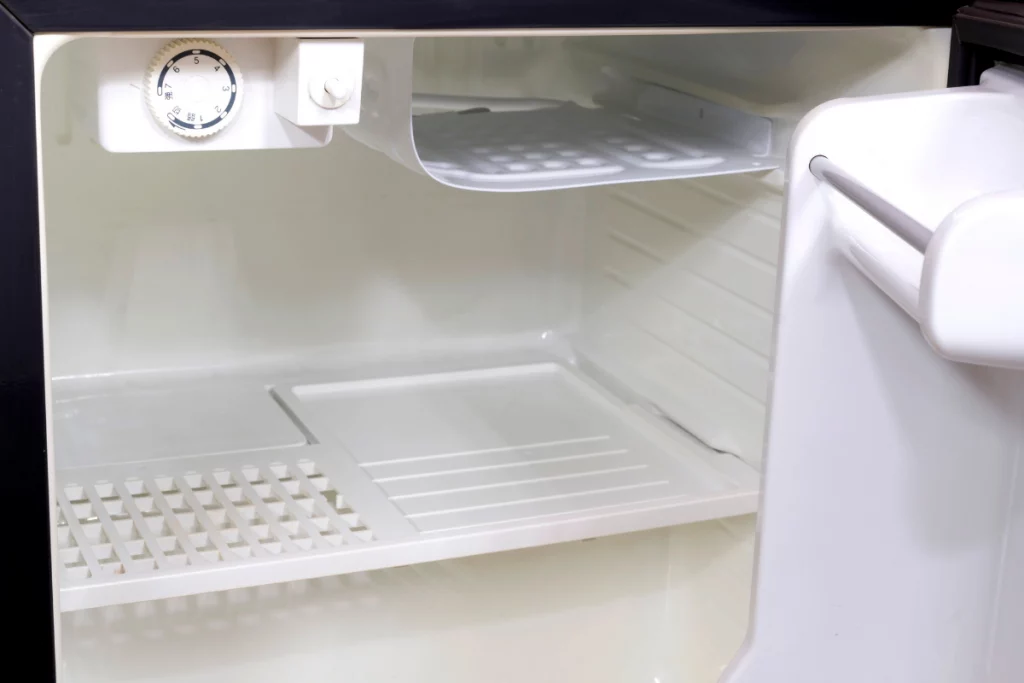Have you ever gazed at your mini fridge and wondered, “What temperature should this thing actually be at?” It’s a common question, especially when we want to ensure our drinks are at that perfect level of cold without freezing, or our snacks are stored safely.
If that’s been on your mind, you’re in the right place. In this article, we’ll dive deep into the world of mini fridge temperatures. Let’s get started!

Table of Contents
What Temp Should a Mini Fridge Be?
Let’s get straight to the point. Generally, a mini fridge should be kept at a temperature between 32°F and 40°F (0°C and 4°C). That’s the sweet spot. Why? Well, it ensures that your food stays cold enough to be safe but not so cold that everything turns into a block of ice.
You see, bacteria, those tiny little critters we can’t see, grow most rapidly in the range of temperatures between 40°F and 140°F, a zone we lovingly call the “danger zone.” So, maintaining your mini fridge below 40°F is crucial for safety, especially if you’re storing perishable items like dairy or certain fresh foods.
But hey, don’t go dialing that mini fridge all the way down thinking “colder is better” – because if you cross below the 32°F mark, you’ll start freezing stuff. And nobody likes a frozen milk in their morning coffee, right? Well, unless you’re making some sort of iced coffee concoction. But that’s a story for another day.

Is 1 or 7 Colder on a Mini Fridge?
Typically, on most mini fridges, the higher the number, the colder the setting. So, if you have a dial that goes from 1 to 7, the “7” setting would make your fridge the coldest. On the other hand, “1” would be the least cold setting. But don’t just crank it up to 7 and call it a day! Every mini fridge is slightly different, and external factors like room temperature can play a role, too.
A good rule of thumb? Start in the middle, maybe around 4, and adjust based on your needs. If things aren’t cold enough after a day or so, nudge it up a number. If your lettuce is looking more like an ice sculpture, maybe dial it back a tad.
However, always check the manual that comes with your mini fridge. Some brands might have unique settings, and we wouldn’t want any assumptions to lead you astray. After all, a well-adjusted mini fridge is a happy mini fridge!
How to Measure and Adjust the Temperature of a Mini Fridge?
Here are a few tips:
- Get a Thermometer: First and foremost, invest in a refrigerator thermometer. They’re not expensive, and they can give you a precise reading of the actual temperature inside your mini fridge.
- Place it Right: Stick or place that thermometer in the center of the middle shelf (not on the door) for the most accurate reading. Wait for a few hours before checking, as this will give it time to adjust and provide an accurate reading.
- Check and Re-check: Read the temperature after about 24 hours. Remember the golden range we talked about: 32°F to 40°F (0°C to 4°C). If the temperature is outside this range, you’ll want to make some adjustments.
- Adjusting the Dial: If your mini fridge is too warm, adjust the dial to a higher number. Too cold? Dial it back a notch. After making any changes, give it another 24 hours and then check the temperature again. It might take a bit of back-and-forth before you nail the perfect setting, but patience is key.
- Consider External Factors: Room temperature can affect your mini fridge. If you’re experiencing a particularly hot summer or a freezing winter, you might need to make seasonal adjustments to your fridge settings. Keep an eye on things!
In essence, while the dial might seem like a guessing game, with a handy thermometer and a bit of patience, you can make sure your mini fridge is doing its job just right.
What are the Optimal Temperature Ranges for Different Items in a Mini Fridge?
Alright, so now we know how to set and check the temperature, but here’s the thing: not all items you stash in your mini fridge are created equal. Different things might prefer slightly different temperatures. Let’s go through some common items you might keep in your mini fridge:
| Food Category | Temperature Range (°F) | Temperature Range (°C) | Additional Notes |
|---|---|---|---|
| Beverages | 35°F to 38°F | 1.5°C to 3.5°C | Most drinks are best served cold but not freezing. |
| Dairy Products | 32°F to 35°F | 0°C to 1.5°C | Aims for the lower end to preserve freshness and prevent spoilage. |
| Fruits and Vegetables | Varies | Varies | Some like it cooler (around 34°F or 1°C), others are fine closer to 40°F (4°C). |
| Leftovers | 35°F to 38°F | 1.5°C to 3.5°C | Best stored to keep them tasty without freezing. |
| Condiments | 35°F to 40°F | 1.5°C to 4°C | Most condiments are fine within this range. |
The key takeaway? While our mini fridge has a preferred general temperature range, individual items might have their own sweet spots within that range. A well-organized fridge, with items placed according to their temperature preferences, can go a long way in ensuring everything stays just right.
Conclusion
So there we have it! Mini fridges might be compact, but they pack a punch when it comes to keeping our items at the perfect temperature. By understanding the right settings and being mindful of individual item preferences, we can make the most out of these little cooling champs. No more guessing games or frozen surprises. Just clear, cold confidence in every open and close of the fridge door. Cheers to always having our favorites ready and at the right chill!




